Washington Hiking Guide | Cap Puckhaber
Welcome to my Washington Hiking Trail Guide, which covers my trip to the Enchantments, Hidden Lake Lookout, Olympic National Park and Lila Lake
The Enchantments
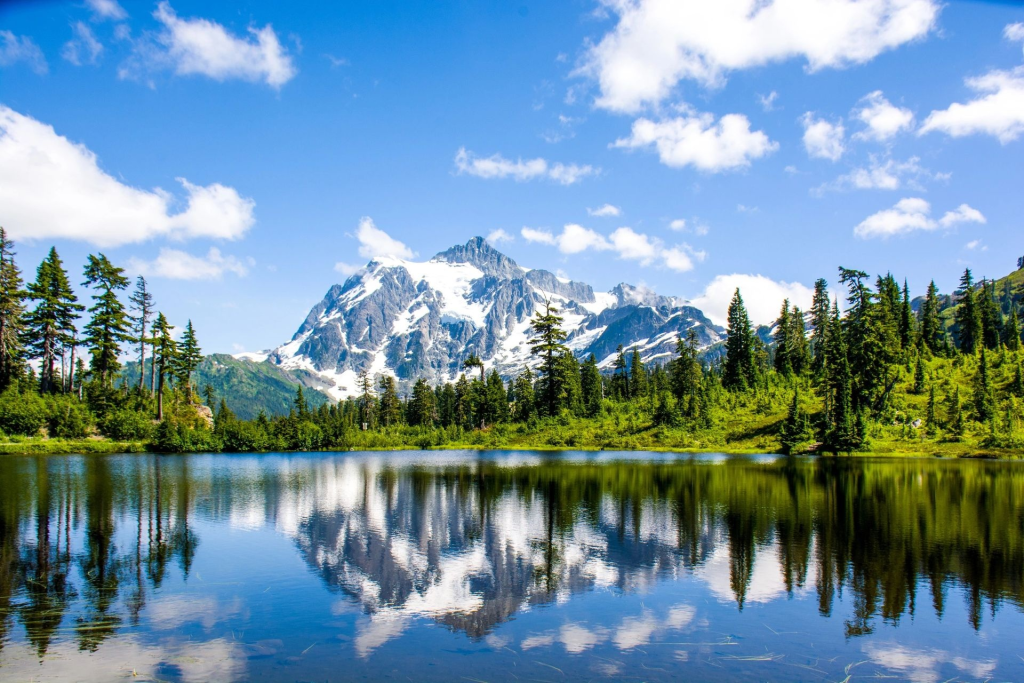
Overview
The Enchantments, near Leavenworth, Washington, offer some of the most stunning, dreamlike landscapes in the Pacific Northwest. We’re talking jaw-dropping alpine lakes, towering granite peaks, and meadows dotted with golden larches. This area, nestled within the Alpine Lakes Wilderness, is truly the crown jewel of Pacific Northwest hiking. Backpacking here for two to four nights is an intensely rewarding experience, but the largest hurdle is often the logistical puzzle rather than the physical climb. To enjoy this place fully, you must understand the different zones, follow strict camping rules, and successfully navigate the highly competitive permit lottery.
Trip Details
Our trip was based out of the Snow Lakes Zone, which allowed us to set up a basecamp before tackling the main event. On our first night, we had an unforgettable encounter with the local wildlife. We were awakened by heavy footsteps and loud sniffing right outside the tent. It turned out to be the area’s famous mountain goats, who are known to be attracted to the salt from hikers’ sweat and urine. They lingered for a couple of hours, providing a wild story and a stark reminder to respect the local inhabitants.
On our second day, we dedicated our time to exploring the high-altitude Core Zone. The hike from Snow Lake up to the Core is where things get truly stunning but also incredibly challenging. The ascent past Lake Viviane requires navigating large, exposed rock slabs where the trail is marked only by rock cairns. The reward for this effort, especially in the fall, is the spectacular sight of golden larches. Their brilliant color against the blue lakes and granite peaks creates a breathtaking palette that feels like a master painting. I chose to spend my time soaking in the views around Sprite Lake while my friends pushed onward, a decision that allowed me to truly appreciate the overwhelming beauty of the area.
Tips, Advice, Permits, and Gear
Securing a Permit
If you’ve heard anything about the Enchantments, you know that the permit lottery is the absolute gatekeeper. An overnight permit is mandatory for camping between May 15 and October 31, and it is notoriously difficult to secure. The success rate for the Core Enchantment Zone often hovers below 2%, so you must apply early through Recreation.gov when the lottery opens. For slightly better odds, consider applying for the Snow Lakes Zone or the Colchuck Zone as your top choices. A permit for these zones still allows you to day-hike into the Core, offering a smart compromise. For official rules and dates, always refer to the U.S. Forest Service page for the Alpine Lakes Wilderness.
Understanding the Zones
The Enchantments area is divided into four zones, and your permit dictates where you can legally camp. The Core Enchantment Zone is the iconic high-altitude section, the Snow Lakes Zone serves as a great basecamp location, the Colchuck Zone provides quick access to the stunning Colchuck Lake, and the Stuart Zone is a quieter alternative. Rangers actively check permits, and you cannot camp outside your designated zone. Strict adherence to Leave No Trace principles, including packing out all waste in WAG bags, is mandatory to protect this fragile ecosystem.
Essential Gear
A trip into The Enchantments is a serious undertaking where every ounce matters. Focus on lightweight, essential gear only. You’ll need a durable, lightweight tent capable of handling high winds and a sleeping system rated for near-freezing temperatures, even in summer. Layering is key, so pack synthetic or wool base layers, a fleece or puffy mid-layer, and a waterproof shell. A bear canister is required for food storage. Finally, navigation tools are non-negotiable. While trails are often marked by cairns, they can disappear on rock slabs, so carry a physical map, a compass, and a downloaded GPS track on your phone. For in-depth gear reviews, sites like Outdoor Gear Lab are an invaluable resource.
Recommendations
Most people experience The Enchantments in one of two ways. The first is the legendary single-day thru-hike, a grueling 18-20 mile trek with massive elevation changes. This option doesn’t require an overnight permit but is a true suffer-fest recommended only for elite, experienced hikers. The ascent up Aasgard Pass is a brutal, 2,000-foot scramble in less than a mile and should not be underestimated.
The second, more enjoyable approach is a multi-night trip, which is what we did. This allows you to truly savor the landscape without rushing. Setting up a basecamp at Snow Lakes or Colchuck Lake lets you explore the Core Zone with just a light daypack, making the steep climbs much safer and more pleasant. Being able to leave our heavy gear behind made the difference between a painful slog and a fantastic exploration.
Conclusion
A trip to The Enchantments is more than just a hike; it’s a profound experience that challenges you physically and rewards you with views you’ll talk about for the rest of your life. The quiet strength of the delicate alpine flora and the brilliant gold of the larches remind us of nature’s resilience and beauty. Go chase that permit, plan smart, and prepare yourself for an adventure that will stay with you long after your muscles have stopped aching.
Hidden Lakes Lookout
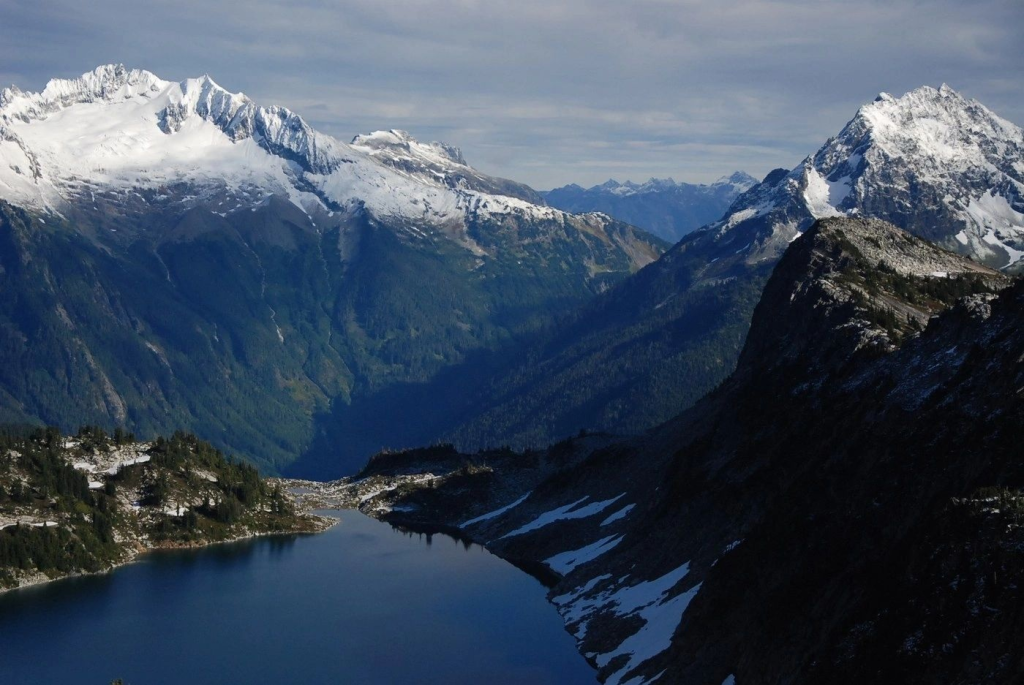
Overview
The Hidden Lake Lookout. Just the name conjures a powerful image of a tiny decommissioned fire tower clinging to a high granite spire at 7,000 feet. This trek was never going to be just another trail; for me, it was the ultimate icon of the famously untamed North Cascades National Park landscape. The journey is a commitment to finding genuine, profound solitude away from the relentless pace of modern life. This specific climb is notoriously brutal, involving 3,300 feet of punishing vertical gain over a mere four miles and culminating in a challenging rock scramble.
Trip Details
The adventure begins on the notoriously rough Forest Service Road 1540. A high-clearance vehicle isn’t just a suggestion; it’s a necessity to navigate the deep potholes and washboard gravel. Arriving early, no later than 7:00 AM on a weekend, is crucial to secure a spot in the tiny parking lot. The trail itself can be broken into three phases. The first is a relentless grind through a thick, shaded forest. This steep section serves as an immediate fitness test.
The second phase emerges from the trees into the full sun of Sibley Creek Meadows. The trail switchbacks up a massive glacial valley, offering explosive views and a riot of wildflowers in late summer. This section contains the last reliable water source at the Sibley Creek crossing, so it’s essential to filter and fill up all your water bottles here. The final phase is a high alpine scramble across rocky slopes and loose scree. The defined trail eventually disappears, replaced by a steep, unmarked route over massive granite boulders to the lookout. This Class 2 scramble demands full attention, careful hand and foot placement, and a calm mind.
Tips, Advice, Permits, and Gear
Logistics and Permits
The lookout itself operates on a First-Come, First-Served (FCFS) basis and is maintained by the Skagit Alpine Club on US Forest Service land. This means no permit is required to stay at the lookout, but you must be prepared to share the space or camp outside on the surrounding rock. Never rely on having the lookout to yourself. It’s important to note that if you descend from the saddle to Hidden Lake itself, you are crossing into North Cascades National Park and will need a separate backcountry permit, which can be researched on the official nps.gov site. Always check the road and trail status on the Washington Trails Association website before you go.
Safety and LNT Protocols
The high alpine environment is extremely fragile. A rudimentary pit privy is available for solid waste, but you must pack out all toilet paper. There is no water at the lookout, so you have to carry everything you need from Sibley Creek. Open fires are strictly prohibited, so all cooking must be done on a backpacking stove. Following these Leave No Trace principles is critical to preserving the pristine nature of this incredible place for all future visitors.
Essential Gear
In addition to the Ten Essentials, three items are non-negotiable for this hike. First, a high-quality wind shell is critical, as the summit is exposed and can be bone-chillingly cold. Retailers like REI offer great options for durable mountain gear. Second, a physical map and compass are vital, especially for the final scramble where the trail vanishes. Third, a pair of full gaiters will keep scree and debris out of your boots and protect your legs from brush in the meadows.
Recommendations
This hike is a rugged and remote expedition that sets it apart from more manicured trails like the Maple Pass Loop. If you desire an authentic challenge and a profound sense of wilderness solitude, Hidden Lake is the right choice. The best hiking window is from late July to early October. Attempting the hike before mid-July often means navigating significant snow, which requires an ice axe, microspikes, and self-arrest skills. While dogs are permitted on the USFS trail, the final scramble can be extremely dangerous for them, and they are not allowed past the saddle into the National Park.
Conclusion
The Hidden Lake Lookout is a true gem of the North Cascades. It is difficult, demanding, and utterly unforgettable. Cresting that final boulder and stepping onto the granite platform next to the lookout brings a moment of immense relief and exhilaration. The rewards far outweigh the strenuous effort, leaving you with the humbling feeling of having truly earned one of the greatest views the Pacific Northwest has to offer. The physical burn and mental fatigue all contribute to a deep satisfaction that transforms the trip from a simple hike into a personal accomplishment.
Olympic National Park: Hoh River Trail
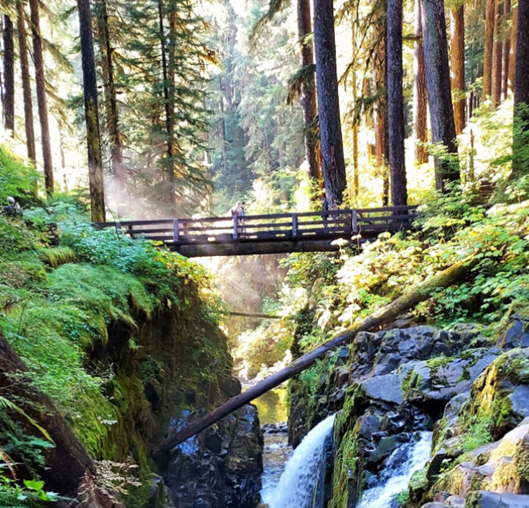
Overview
If you’re planning on visiting Olympic National Park, you absolutely can’t miss the Hoh Rainforest. It’s quite possibly one of the greenest places you’ll ever see, a world where everything is draped in thick, velvety moss. The Hoh Rainforest is renowned for being one of the quietest places on Earth, and the silence out there is profound. This backpacking trip takes you for miles through this lush forest before the trail transforms, climbing out of the rainforest to reward you with breathtaking views of Mount Olympus and the surrounding range. The journey also features an iconic rope ladder down a steep chute that will definitely make the trip memorable.
Trip Details by Day
Day 1: A Short Hike to Mt. Tom Creek
Our journey began on a Friday evening with a 2.9-mile hike from the Hoh River Visitor Center to the Mt. Tom Creek backcountry site. The drive from Seattle took nearly five hours with traffic, but arriving late meant we avoided any lines at the park entrance. The trail starts flat and easy, immediately immersing you in the mystical wonderland of the rainforest. The Mt. Tom Creek campground is nicely spread out, with a convenient bear wire and most sites situated right along the Hoh River.
Day 2: Lewis Meadow and a Wet Surprise
The first full day was a 7.6-mile venture to Lewis Meadow. The trail remains pleasant and flat, lulling you into a false sense of security. Our primary challenge came at two major creek crossings. Due to the spring melt, the water was a rushing, knee-deep torrent. Trekking poles were critical for stability, and despite our caution, a slip on a slick rock resulted in some wet gear. We arrived at Lewis Meadow with plenty of time to lay everything out on sunny rocks to dry. Lewis Meadow is a fantastic basecamp with ample space and great water access.
Day 3: The Ascent to Glacier Meadows
Leaving our heavy gear at camp, we set off on a day trip to Glacier Meadows. After a flat start, the trail began a relentless ascent. Past Elk Lake, the path narrows onto ledges with loose scree and steep drop-offs, demanding careful footing. Then comes the final challenge: the iconic rope ladder. This 100-foot ladder descends a steep, dusty chute at a 50-degree angle. It’s a serious adrenaline rush that requires slow, careful movement. At the top, we were rewarded with an epic, panoramic view of the Olympic mountain range, which made the entire journey worth it.
Day 4: The Long Walk Out
Our final day was a relaxing 10.4-mile return trip to the visitor center. The journey was mostly flat or downhill and felt much easier after the previous day’s adventure. Instead of fording the major creeks again, we opted for a primitive bypass trail, which was rougher but kept our boots dry for the final stretch back to the car.
Tips, Advice, Permits, and Gear
Permits and Camping
A Wilderness Camping Permit is required for any overnight stay and can be reserved through the Recreation.gov website. The system is competitive, so plan ahead. For camping, Mt. Tom Creek (2.8 miles) is perfect for a late start. Lewis Meadow (10.4 miles) is the ideal basecamp, as it positions you perfectly for the strenuous day-hike to Glacier Meadows with a lighter pack. All established campsites have easy access to water and are equipped with bear wires for proper food storage. If you’re not comfortable with bear wires, a certified bear canister is also acceptable.
Essential Gear
This is one of the wettest places in the continental United States, so high-quality waterproof gear is mandatory. A reliable rain jacket, rain pants, and waterproof boots are essential. I also strongly recommend gaiters to keep mud and water out of your boots. Trekking poles are another non-negotiable item. They provide crucial stability in fast-moving creek crossings and save your knees on the steep, long ascents and descents. Light gloves are also highly recommended for the rope ladder to prevent rope burn.
Recommendations
The Hoh River Trail to Glacier Meadows is a strenuous hike best suited for experienced and well-prepared backpackers. The first 10 miles are deceptively flat, but the final ascent is incredibly steep and challenging. For the best conditions, plan your trip for late July, August, or early September. During this window, the snowpack at Glacier Meadows is likely melted, and creeks are at their lowest flow. While the rope ladder is an adrenaline rush, it’s not overly dangerous if you are careful. Maintain three points of contact, move slowly, and allow only one person on it at a time.
Conclusion
This was an incredible route to kick off the backpacking season. The full hike to Glacier Meadows is not for the faint of heart, but the journey is just as memorable as the final viewpoint. You’ll cover nearly 35 miles, gain over a mile of vertical elevation, and navigate challenges that test your nerve. It’s a beautiful and deeply rewarding experience that showcases the stunning diversity of Olympic National Park, from its serene mossy depths to its rugged alpine peaks.
Lila Lake and the Rampart Lakes
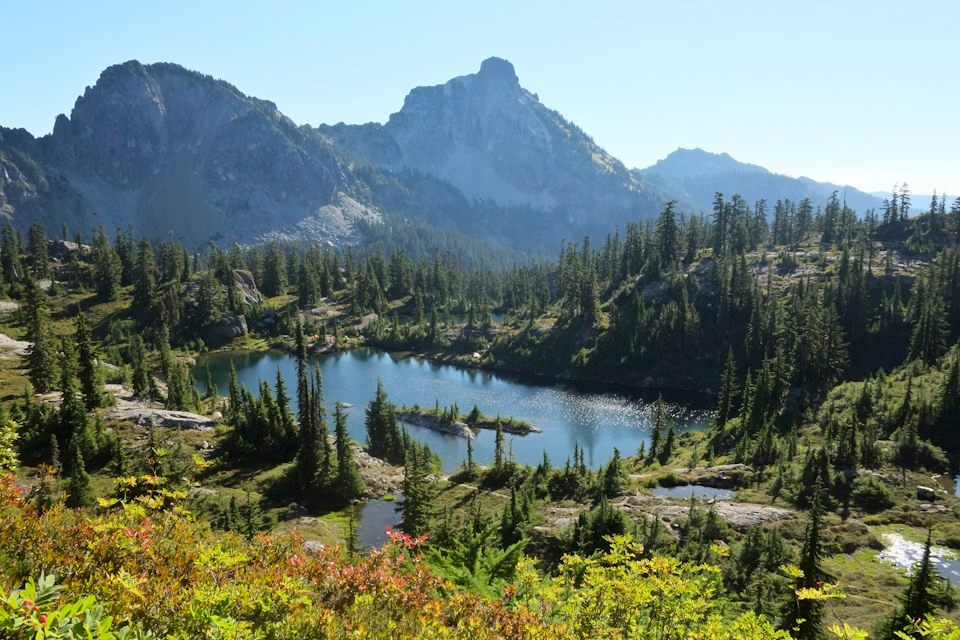
Overview
If you’re looking for a scenic and peaceful hike in Washington, Lila Lake is an excellent destination. It’s one of those iconic spots in the Alpine Lakes Wilderness that you see in photos and immediately add to your bucket list. For us, seeing Lila Lake was the cherry on top of an ambitious three-night backpacking trip. We set up a basecamp at the stunning Rampart Lakes and tackled a day hike up the formidable Alta Mountain. This journey was no walk in the park; it tested our endurance, pushed our limits, and left us completely exhausted. It was also one of the most incredible backpacking trips I’ve ever taken, offering a full-immersion experience into the rugged heart of the Cascades.
Trip Details by Day
Day 1: The Grueling Ascent to Paradise
Our trip started at the Rachel Lake trailhead with a plan to basecamp at Rampart Lakes. The first few miles are deceptively pleasant, following Box Canyon Creek through a lush forest. About three miles in, everything changes. We hit a section grimly nicknamed the “mile from hell” by fellow hikers on sites like AllTrails, and the name is no exaggeration. The trail becomes a brutal, nearly vertical climb up a path of tangled roots and rocks, gaining 1,300 feet in just one mile. After reaching the crowded Rachel Lake, we pushed up a final, steep ridge on much-improved switchbacks. The reward was a breathtaking granite basin dotted with dozens of pristine alpine lakes.
Day 2: Exploring the Tarns of Rampart Lakes
Waking up at Rampart Lakes was a magical experience. We dedicated our second day to rest and exploration, wandering through the labyrinth of small alpine lakes, or tarns. We followed faint boot paths, scrambled over granite slabs for better views, and even took a shockingly cold but refreshing swim in one of the larger lakes. The Ramparts are a backpacker’s paradise, and having a full day to simply exist in the landscape, surrounded by jagged peaks and endless vistas, was a true gift.
Day 3: Summiting Alta Mountain
Our third day’s mission was to summit Alta Mountain. The trail took us past Lila Lakes before switchbacking steeply up an exposed, rocky slope. The final push was a scramble, but the anticipation of the view kept us going. Reaching the summit was the absolute climax of our trip. The 360-degree panorama of the Alpine Lakes Wilderness was staggering. We could see Mount Rainier dominating the southern horizon and an endless sea of jagged Cascade peaks to the north.
Day 4: The Long Hike Out
Our final morning was bittersweet. We packed up camp, making sure to follow all Leave No Trace principles, and began the long journey back. The descent was physically demanding, especially navigating the “mile from hell” on tired legs. By the time we reached the gentler forested section, our legs were trembling with fatigue. Reaching the car and dropping our heavy packs for the last time brought a feeling of pure relief and profound accomplishment.
Tips, Advice, Permits, and Gear
Permits and Planning
This trip requires careful planning. The trail is located in the Okanogan-Wenatchee National Forest. You’ll need a NW Forest Pass to park at the trailhead and must fill out a self-issued wilderness permit at the kiosk for overnight stays. Campfires are strictly prohibited at Rachel Lake and anywhere in the Rampart Lakes basin. The best time to go is from mid-July to September to avoid significant snow. Always check recent trip reports on the Washington Trails Association (WTA) website for the latest conditions.
Essential Gear
You’ll need all your standard backpacking gear, including a tent and sleep system appropriate for mountain weather. A reliable water filter is essential, as is a backpacking stove due to the campfire ban. Sturdy hiking boots with good ankle support are a must for the rocky terrain. I also highly recommend trekking poles; they were a lifesaver on both the brutal ascent and the grueling descent, providing stability and saving our knees.
Recommendations
I want to be perfectly clear: the hike to Rampart Lakes is very difficult. Do not underestimate the “mile from hell” based on distance alone. You need to be in good physical condition and have experience with challenging terrain. While a day hike to Rachel Lake is possible for strong hikers, attempting to reach Rampart Lakes or Alta Mountain in a single day would be an extremely strenuous undertaking. The magic of this area is best experienced by staying overnight, allowing you to fully explore the basin and enjoy the stunning sunsets and sunrises.
Conclusion
Looking back on our four days in the Alpine Lakes Wilderness, the one word that comes to mind is “epic.” The journey was undeniably tough. But the rewards were tenfold. The serene beauty of the Rampart Lakes basin and the awe-inspiring view from the summit of Alta Mountain are moments I will never forget. This is not a trip for beginners, but for those prepared for the challenge, it offers an unforgettable experience that reminds you of the power of perseverance and the incredible beauty that awaits when you push yourself just a little bit harder.
More Blogs from Cap Puckhaber

Follow Cap Puckhaber on Social Media

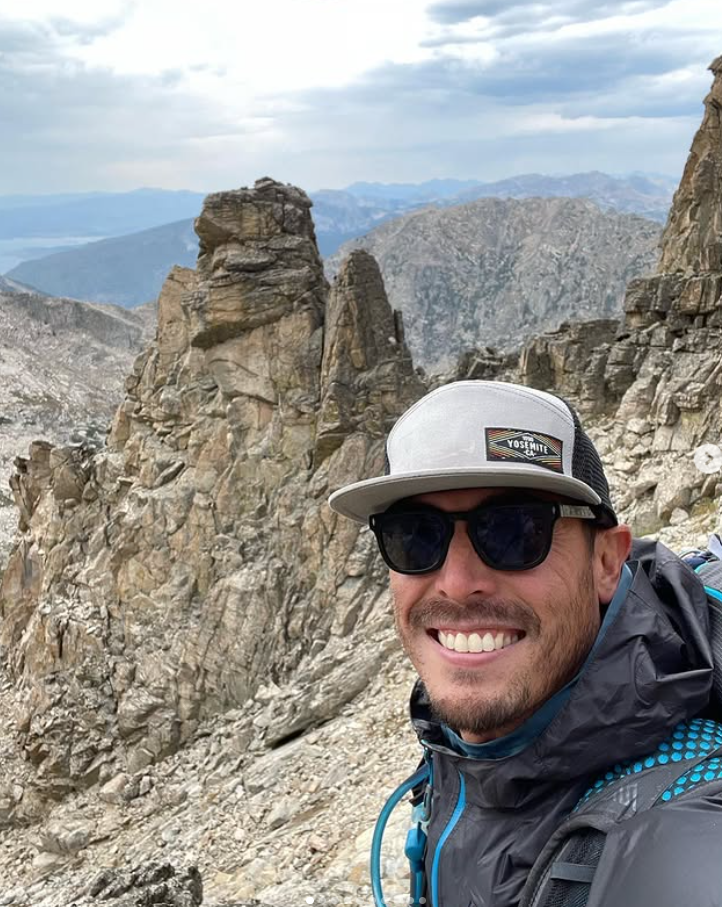
Cap Puckhaber
Backpacker, Marketer, Investor, Blogger, Husband, Dog-Dad, Golfer, Snowboarder
Cap Puckhaber is a marketing strategist, finance writer, and outdoor enthusiast from Reno, Nevada. He writes across CapPuckhaber.com, TheHikingAdventures.com, SimpleFinanceBlog.com, and BlackDiamondMarketingSolutions.com.
Follow him for honest, real-world advice backed by 20+ years of experience.